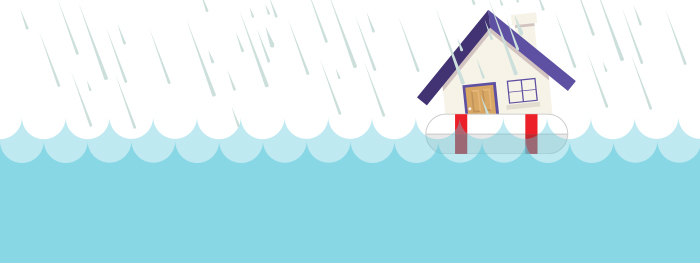Flood Insurance: Be Prepared for Rising Waters and Changing Rates
Water damage to your home from a leaking pipe, a broken dishwasher, or a hole in your roof — water that comes from the top down — is typically covered by your homeowners insurance policy (up to your policy limits). However, damage from water that enters from the ground up is excluded from most homeowners policies and requires a separate flood insurance policy. To be considered a flood for insurance purposes, water must cover at least two acres or affect two properties. Typically, there is a 30-day waiting period before flood coverage goes into effect, so property owners should not wait until there is an imminent threat to buy flood insurance.

Ninety percent of natural disasters in the United States involve flooding, causing billions of dollars in annual losses.1 Most flood coverage is provided under the National Flood Insurance Program (NFIP). Homeowners who currently have (or may purchase) a flood policy should be aware that the NFIP has rolled out a new risk assessment model, as this change is expected to have an impact on premiums. Looking ahead, higher insurance costs could be an issue for anyone who aspires to own a coastal or waterfront home.
Accounting for Risk
Mortgage lenders require flood insurance for homes in designated high-risk zones. Even if you own your home outright or do not live in a flood-prone area, you may want to consider coverage. About 20% of flood insurance claims are in low- to moderate-risk areas.2
The Federal Emergency Management Agency (FEMA) calculates the degree of risk in your community based on assessments of rainfall, topography, tidal surge, flood control measures, and other variables. Under the old system, flood insurance premiums were based on the level of risk indicated on FEMA’s flood-hazard maps, along with other factors such as building elevation and age. In general, all properties in a particular flood zone were rated for the same level of risk.
Expected Rate Changes with Risk Rating 2.0
Share of flood policyholders who will see their monthly premiums:
Decrease 23%
Increase up to $10 per month 66%
Increase $10 to $20 7%
Increase more than $20 4%
Source: Federal Emergency Management Agency, 2021
As of October 1, 2021, a new system called Risk Rating 2.0 provides a more individualized picture of a property’s risk, using a wider range of data including the distance to the water threat and the cost to rebuild a home. This system is intended to make it easier for homeowners to understand the actual risk to their homes and set premiums more in line with that risk. It’s expected to raise premiums for higher-valued and/or higher-risk homes and lower them for lower-valued and/or lower-risk homes. For existing policies, the new pricing takes effect on April 1, 2022. To ease the transition for owners of vulnerable, high-valued homes, annual increases are capped at 18% until they reach the full rate.
1–2) Insurance Information Institute, 2021
This information is not intended as tax, legal, investment, or retirement advice or recommendations, and it may not be relied on for the purpose of avoiding any federal tax penalties. You are encouraged to seek guidance from an independent tax or legal professional. The content is derived from sources believed to be accurate. Neither the information presented nor any opinion expressed constitutes a solicitation for the purchase or sale of any security. This material was written and prepared by Broadridge Advisor Solutions. © 2022 Broadridge Financial Solutions, Inc.
